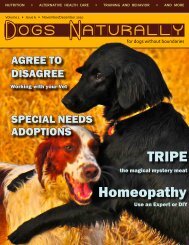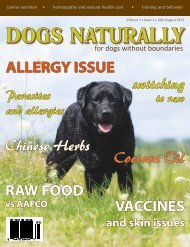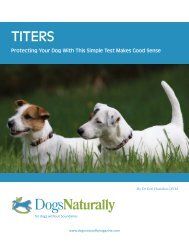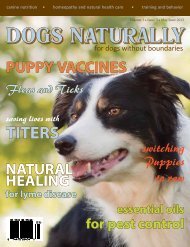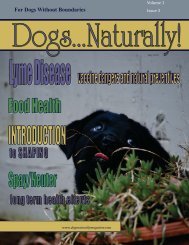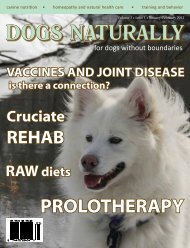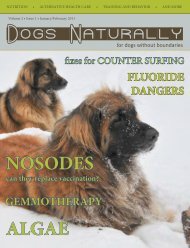For Dogs Without Boundaries - Dogs Naturally Magazine
For Dogs Without Boundaries - Dogs Naturally Magazine
For Dogs Without Boundaries - Dogs Naturally Magazine
You also want an ePaper? Increase the reach of your titles
YUMPU automatically turns print PDFs into web optimized ePapers that Google loves.
for high-risk exposure situations. Vaccines,<br />
while necessary and generally safe<br />
and efficacious, can be harmful or ineffective<br />
in selected situations.<br />
contamination resulting from the shedding<br />
of vaccine virus is a serious concern.<br />
More importantly, the ability of<br />
new infective agents to develop and<br />
spread poses a threat to both wild and<br />
domestic animal populations. The controversy<br />
in weighing the risks and benefits<br />
of MLV versus killed vaccines is building.<br />
Vaccine manufacturers seek to<br />
achieve minimal virulence (infectivity)<br />
while retaining maximal immunogenicity<br />
(protection). This desired balance may<br />
he relatively easy to achieve in clinically<br />
normal, healthy animals but may be<br />
problematic for those with even minor<br />
immunologic deficit. The stress associated<br />
with weaning, transportation, surgery,<br />
subclinical illness, and a new home<br />
can also compromise immune function.<br />
Furthermore, the common viral infections<br />
of dogs cause significant immunosuppression.<br />
<strong>Dogs</strong> harboring latent viral<br />
infections may not be able to withstand<br />
the additional immunological challenge<br />
induced by MLV vaccines. The increase in<br />
vaccine-associated distemper and parvovirus<br />
diseases are but two examples of<br />
this potential. So -- why are we causing<br />
disease by weakening the immune system<br />
with frequent use of combination<br />
vaccine products After all vaccines are<br />
intended to protect against disease. It<br />
is well-recognized by experts in the field<br />
that a properly constituted killed vaccine<br />
is always preferable to one of MLV<br />
origin. Killed vaccines do not replicate in<br />
the vaccinated animal, do not carry the<br />
risk of residual virulence and do not shed<br />
attenuated viruses into the environment.<br />
On the other hand, MLV vaccines<br />
are capable of stimulating a more sustained<br />
protective response. So what does<br />
the future hold here Veterinarians,<br />
scientists, breeders and owners need to<br />
voice their concern and discontent with<br />
the present industrial vaccine practices.<br />
We need to urge manufacturers to seek<br />
alternatives. Even if killed vaccines are<br />
proven to be somewhat less efficacious<br />
(produce lower levels or less sustained<br />
protection) than MLV products, they are<br />
more safe. All killed vaccines on the market<br />
today have passed current efficacy<br />
and safety standards in order to be licensed<br />
for use by the USDA. The issue<br />
is to what extent being more effective<br />
elicits a benefit rather than a risk. The<br />
future will evolve new approaches to<br />
vaccination including sub-unit vaccines,<br />
recombinant vaccines using DNA technology,<br />
and killed products with new<br />
adjuvants to boost and prolong protection.<br />
These are not simple solutions to a<br />
problem, however, because early data<br />
from recombinant vaccines against some<br />
human and mouse viruses have shown<br />
potentially dangerous side-effects by<br />
damaging T-lymphocytes. Contributing<br />
factors were shown to be the genetic<br />
background of the host, the time or dose<br />
of infection, and the makeup of the vaccine.<br />
We are obviously still a long way<br />
from producing a new generation of improved<br />
and safe vaccines. In the meantime,<br />
we need to return to using killed<br />
products whenever they are available<br />
and should consider giving them more<br />
often (twice yearly rather than annually)<br />
Cancer and Immunity<br />
Proper regulation of cellular activity and<br />
metabolism is essential to normal body<br />
function. Cell division is a process under<br />
tight regulatory control. The essential<br />
difference between normal and tumor<br />
or cancerous cells is a loss of growth control<br />
over the process of cell division. This<br />
can result from various stimuli such as<br />
exposure to certain chemicals, viral infection,<br />
and mutations, which cause cells to<br />
escape from the constraints that normally<br />
regulate cell division. Proliferation<br />
of a cell or group of cells in an uncontrolled<br />
fashion eventually gives rise to a<br />
growing tumor or neoplasm. Of course,<br />
tumors can he both benign (a localized<br />
mass that does not spread) or malignant<br />
(cancerous), in which the tumor grows<br />
and metastasizes to many different sites<br />
via the blood or lymph.<br />
Tumor cells also express a variety of proteins<br />
called "neoantigens" on their surface,<br />
and many of these are different<br />
from antigens found on normal cells.<br />
These new or altered proteins are recognized<br />
as foreign by the immune system,<br />
and so trigger an immunological<br />
attack. There are a large number of<br />
them known as tumor-specific or tissuespecific<br />
antigens, whereas others recognize<br />
the blood group systems, histocompatibility<br />
complex, and viruses. The<br />
situation in cancer is complex because<br />
not only can immunologically compromised<br />
individuals become more susceptible<br />
to the effects of cancer-producing<br />
viral agents and other chemical carcinogens,<br />
the cancer itself can be profoundly<br />
immunosuppressive. The form of immunosuppression<br />
usually varies with the<br />
tumor type. <strong>For</strong> example, lymphoid tumors<br />
(lymphomas and leukemia) tend to<br />
suppress antibody formation, whereas<br />
tumors of T-cell origin generally suppress<br />
cell-mediated immunity. In chemically<br />
induced tumors, immunosuppression is<br />
usually due to factors released from the<br />
tumor cells or associated tissues. The<br />
www.dogsnaturallymagazine.com January/February 2010 | 41




